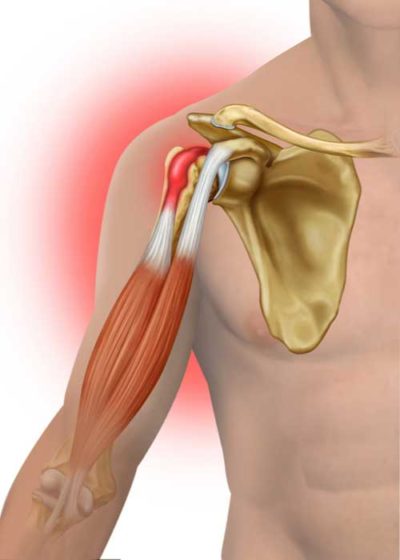Biceps Tendonitis Specialist

Are you an athlete who participates in sports that involve throwing overhead? If so, you may be at risk of developing biceps tendonitis. Biceps tendonitis can develop from overuse, repetitive overhead motions or aging. Biceps tendonitis specialist, Dr. Matthew Provencher provides diagnosis and both surgical and nonsurgical treatment options for patients in Vail who have developed biceps tendonitis. Contact Dr. Provencher’s team today!
What is Biceps Tendonitis?
Even though the biceps tendons are quite tough, they can become inflamed from repetitive movements and the natural aging process. Commonly located in the long head biceps tendon that attaches the biceps muscle to the front of the shoulder, biceps tendonitis causes patients to experience bicep pain during movement that involves the front of the shoulder. Dr. Matthew Provencher, orthopedic shoulder specialist serving the Vail, Aspen, Colorado Springs and Denver, Colorado area, specializes in diagnosing and treating biceps tendonitis.
Repetitive shoulder movement and overuse are the main causes of biceps tendonitis, but the shoulder condition may also affect active individuals and athletes as they age and the shoulder joint begins to wear out. Other common shoulder injuries can cause bicep pain and inflammation, including a rotator cuff injury, bone spurs, shoulder trauma, shoulder arthritis, and multi-directional instability.

What are the Symptoms of Biceps Tendonitis?
As the long head biceps tendon becomes damaged from overuse or aging, it displays several warning signs, such as intermittent or constant bicep pain located at the front of the shoulder joint that radiates down to the biceps muscle. Many patients experience the bicep pain more intensely when the arm is moved in front of the body or raised above the shoulder. Other common biceps tendonitis symptoms include sensitivity in the injured area, local redness, and a snapping sensation during shoulder movement.
How is Biceps Tendonitis Diagnosed?
In order to diagnose biceps tendonitis as the cause of bicep pain, Dr. Provencher must perform a physical examination to test for inflammation and tenderness. He may also perform x-rays and an MRI scan to rule out other shoulder injuries and confirm the diagnosis.
How to Treat Biceps Tendonitis Without Surgery:
Biceps tendonitis is generally treated by resting the injured area and slowly working back into light movements under the guidance of Dr. Provencher and his orthopedic team. Dr. Provencher may also recommend applying ice to the affected area and taking medications to relieve bicep pain and inflammation. A corticosteroid injection may be utilized to reduce pain for a longer duration in certain patients.
When Do I Need Surgery for Biceps Tendonitis?
Dr. Provencher may recommend arthroscopic shoulder surgery in severe cases of biceps tendonitis that do not improve with non-surgical measures. In certain cases, Dr. Provencher will remove the damaged section of the biceps tendon and reattach the remaining tendon to the upper arm bone (humerus), known as biceps tenodesis. In more severe cases where the tendon is so damaged it cannot be repaired, Dr. Provencher may release the damaged tendon from its attachment site with the use of a procedure known as biceps tenotomy.
For additional resources on bicep pain caused by biceps tendonitis, please contact orthopedic shoulder specialist Dr. Matthew Provencher serving patients from Vail, Aspen, Colorado Springs and Denver, Colorado.